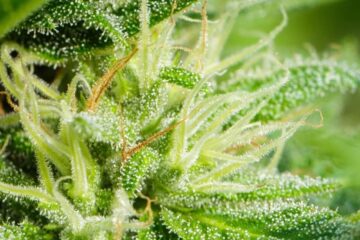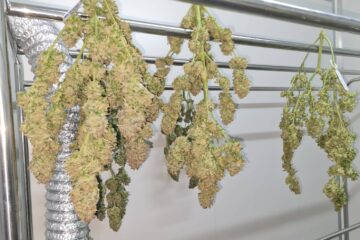So what is the best temperature for growing weed and what about the humidity in your grow room? Check it out!
Getting the temperature right for your cannabis plants is an essential part of each stage of the growing process. If the temperature in your grow room or outdoors is too hot or too cold, your young weed plants will not be able to photosynthesize properly, and this will inevitably affect their growth and development. However, it is not as simple as saying ‘this is the correct temperature; the temperature needs of the plants vary according to their stage of development, so you must have some knowledge of their requirements.
To help you, I have written this guide which will explain the best temperature and humidity for growing weed for each phase of your young weed plants.
Now, I understand that establishing the ideal temperature for weed plants can be tricky – some say that it is as much instinct as it is science. However, it is certainly possible to work things out for the growing conditions of your plants, and this article will tell you everything you need to know.
What you need to know about temperature and humidity
The first thing you need to understand is the close relationship between temperature and humidity levels. Let’s look at science. Humidity refers to the amount of water vapor present in the air. At higher temperatures, molecules move at top speeds; thus, the probability of condensation of water vapor due to the collision of molecules is less. This makes the air hold more water vapor at high temperatures. In other words, as the temperature increases, the humidity of air also increases.
Most plants including cannabis plants, need humid air to thrive. This is because the pores through which they breathe lose most of their moisture when the surrounding air is dry, a loss that the plant can’t always replace through the water absorbed by its roots. The thinner the leaf – and cannabis plants have quite small, narrow leaves, the higher its need for humidity.
When deciding the correct temperature for your plants, therefore, it is also sensible to assess the humidity levels as the two go hand-in-hand. To do this, you should invest in a good-quality thermometer and a hygrometer, ideally digital models with the ability to store historical maximum and minimum levels.
When the temperature is 68°F (20°C), air can absorb 7.2 ml of water maximum. When this occurs, the air has a relative humidity of 100 percent. There will be so much water vapor that the air will be as dense as a cloud and will affect your ability to see anything. Air with a temperature of 32°F (0°C) is only able to absorb about 5 ml of water. This is the reason why the air is a lot drier in the winter than in the summer.
Temperature and humidity for the germination phase
The first moments of your cannabis plant’s life are crucial. Germinating seeds indoors will allow you to have more control over the temperature, but it is also possible to do so outdoors if the climate conditions allow. Having a high temperature (from 22 to 26°C) is an important factor for your seeds to decide to emerge into the world.
However, the temperature must not fall to less than 20 degrees Celsius nor rise to more than 30. If you are using a greenhouse for the germination phase, be warned that it can get sweltering so you must regularly monitor the temperature. Humidity must also be continuously monitored. If the seed trays dry up, germination will not take place or recently sprouted shoots will wither and die.
You must not forget to add water when necessary – a spray dispenser is gentle for this, but you should not give them too much water. The seeds should only be soaking wet during the first two days.
Once the first seedlings emerge with two cotyledons (the first two round leaves that develop), they should be carefully transplanted. If the seeds are auto flowering, you should transplant them to a large pot. If they are feminized seeds, however, you can transplant them to a smaller container and move them to the large bowl when they are a bit more established.
Best temperatures and humidity for the seedling phase
The optimal conditions for cannabis seedlings are a sunny, warm (20-25ºC) and humid environment with well-circulated air. Their underdeveloped root systems mean that seedlings need to be exposed to lots of light and heat. Problems arise as their immaturity means that they cannot withstand high temperatures. Therefore, I recommend that growers maintain 20ºC to 25ºC indoor environments when the lights are on.
Humidity levels also need to be high. Levels between 65 percent and 70 percent are sufficient for seedlings to absorb enough water through their leaves.
Optimal temperatures for the vegetative phase
You can start to relax a bit during the vegetative phase. As cannabis plants mature, they grow stronger and better able to cope with extremes of heat. They start to be more resistant to heat and cold. You can raise the temperature to as much as 30ºC.
As the roots have sufficiently developed to absorb plenty of water, you may wish to reduce humidity levels by 5 percent each week. The relative humidity should ideally fall between 40 percent and 70 percent.
The best humidity and temperatures for the flowering phase
The last phase of the cannabis growth cycle is the flowering phase. Growers should aim to maintain warm temperatures that are pretty much the same as when the plants were at the seedling stage. Ensure that the temperature stays at a nice warm 20ºC to 25C to prevent buds from burning their terpenes. This will allow your plants to produce deliciously potent flowers.
It is also a good idea to lower humidity levels to about 40 percent to 50 percent, especially during the late flowering phase. This encourages the production of highly-prized resin and a higher terpene content leading to a more aromatic and flavorful crop.
Cultivators should be advised that typical temperature variance when the lights are switched off is 5ºC, and this applies to all the phases of development.
Temperatures that are too cold
Temperatures that are too cold will slow down a cannabis plant’s metabolism and its roots system will become increasingly ineffective. If temperatures drop below 12 degrees, the plant is even at risk of death.
The obvious solution to boosting the temperature of the grow room is to get an electric heater and plug it in. This has several disadvantages, however, mainly due to its high consumption of electricity but also because of its drying nature which can affect levels of humidity, and the direct distribution of the heat which makes it hard for all the plants to enjoy the uneven heat. An oil-filled portable radiator is another option if you can get one which isn’t too large to fit into the grow space. I recommend small tubular electric heaters which can be placed conveniently on the floor and only use a few watts of electricity. Radiating cables for indoor use are another excellent alternative, especially if you need to heat trays of seedlings.
Temperatures that are too hot
Reducing heat levels in a grow tent can be much harder to control than the reverse. I recommend using electric fans to circulate the air as much as possible to disperse the heat and thus cool the young cannabis plants.
Placing an exhaust fan in the ceiling vent of your grow tent is also highly effective at reducing heat. After all, heat always rises to the top.
You could also use a cooling humidifier which reduces temperatures while boosting humidity levels. Just take care that the humidity does not increase too much for the growth phase. Remember, seedlings need higher levels of humidity than vegetative marijuana plants, for which 40 percent is optimal.
Kevin


